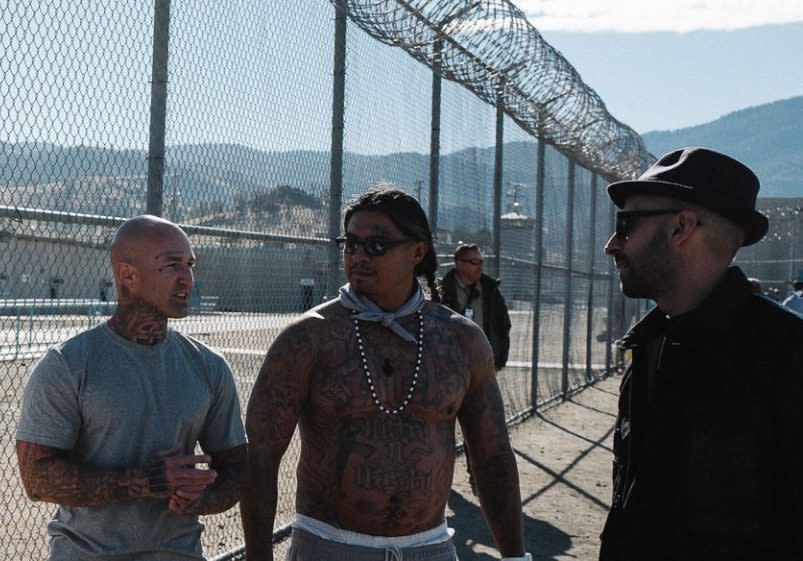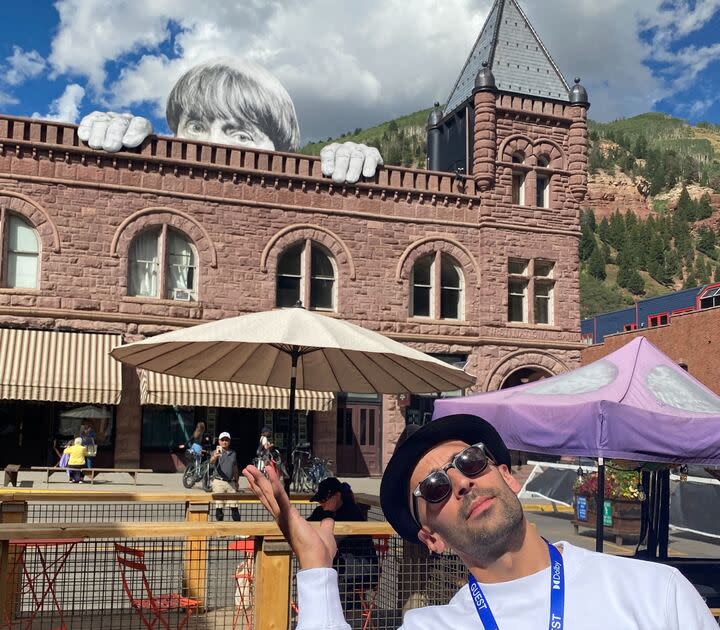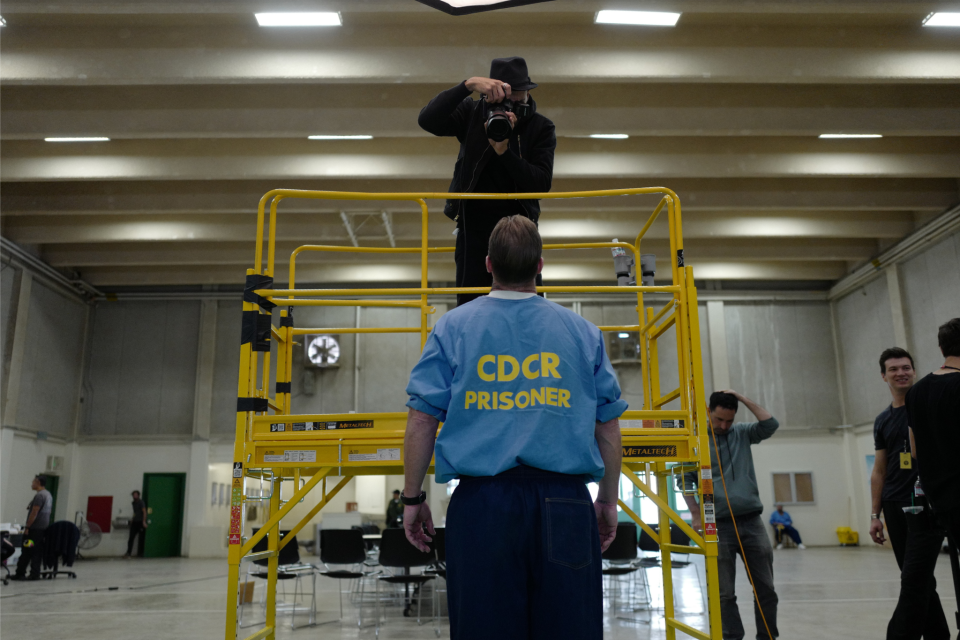Telluride Breakout ‘Tehachapi’ Sees Unlikely Face Save Hopeless Place

Fitting of the man who made “Faces Places,” a road trip movie alongside French New Wave icon Agnès Varda, to be chatting it up with Alfonso Cuarón, another highly regarded international filmmaker, before an interview with IndieWire at 50th Telluride Film Festival.
Seated at a coffee shop across the street from the theater currently screening his new film “Tehachapi,” one that just so happens to have one of his signature installation — a blown-up black and white photo of Varda and her hands peeking over the rooftop — staring back at him, artist and documentarian JR can’t help but have his late friend on his mind.
More from IndieWire
'Reptile' Review: New England Thriller Isn't Cold-Blooded So Much as Lacking a Pulse
'Donkey Skin' Uses the Power of Song to Remind the World That Incest Is a Massive Bummer
“I feel she’s still with me. I feel like she prepared me for quite a journey and she took the time, those years that she taught me so much, and I knew at that time I could not process everything, but thank God it’s processing now,” he said. ”Telluride has done this magic that nobody could understand ‘Visages Villages,’ what that film was, and then it premiered here for the first time ever. And then it created that excitement. And then I remember from the work with Agnes that took us all the way to the Oscars, and it was an incredible journey. And so it’s beautiful to see that here in Telluride up there in the mountain,” said the filmmaker, pointing to his artwork. “And not that far from Tehachapi. This is the beginning of [that] journey starting, and literally it started 48 hours ago.”
“Tehachapi,” a documentary named after the town that houses the California Correctional Institution, a supermax state prison, follows JR collaborating with those incarcerated at the facility, and its staff to paste a work of art that spans the entire prison yard. What happened afterward has made the director an unexpected herald of effective prison reform. “I couldn’t have predicted that so many things would actually change,” said JR.
In fact, when friend and fellow artist Sol Guy shared the suggestion that he do an art project at a prison, JR said “That doesn’t work with institutions. I’ve tried in France, it’s so much paperwork. Of course I’m interested, but no, I won’t do it.” Him and his team did not have the bandwidth to go through what’s normally “100 meetings to try to get one permit to maybe take a photo.” Though he finally acquiesced, JR did not anticipate Guy’s friend Scott Budnick, an accomplished film producer and anti-recidivism activist, to have a direct line to the California government, a highly influential official to recognize the artist from being part of his 2019 San Francisco Museum of Modern Art installation, and then basically grant JR what felt like carte blanche as far as clearances go.

After a half hour on Google Earth, he found the California Correctional Institution, and specifically picked it for its concrete yard serving as the most ideal canvas, not knowing the full implications of bringing his concept to a supermax facility. Though it’s as secure a prison as one can find, the crew JR sent to scout CCI came back and said “Yeah, it was one of the craziest things ever, we could walk anywhere.”
Once he arrived in Tehachapi, JR was given a crash course in what to expect inside CCI, and advised to find his designated chair and not touch anyone. Still, upon meeting the inmates, he made an effort to shake each person’s hand, “which to me seems like the normal thing to do when you go through,” said JR. “After we painted the entire prison, half of those guys still to this day say the most incredible thing for them is that I shook their hand. I can’t believe that. It’s the little things that actually really matter.”
There were still aspects of prison culture that threw him for a loop, but the spirit of the project was to not cast any aspersions. “In my head I’m like, ‘Oh, there’s a guy with a swastika on his face in front of me. I’ve seen that in “American History X,” but I’ve never seen that in real life.’ So when he came for me to photograph him, I thought it would be a good opportunity for me to just ask him, ‘How did you end up with this on your face?’ So I did,” said JR. “And he explained to me it’s a gang thing in there. He would love to remove it, but in prison you can’t.”
The film shows how violence was still a present issue in CCI as JR worked on the project, “and that represents quite a fair amount of what’s happening,” he said. “But there’s also beautiful things happening there. My role and my goal have always been to try to put all my energy and focus on the positive. And by enlarging and putting light on the positive, this is what happened.” JR added, “I have to remain a utopist. That’s what Agnes used to tell me constantly. We got to remain the utopist. If the artists are not the utopists anymore, then who else will be?”

Right as he was sharing what the reception of the film had been in Telluride, having met festival goers who were moved to tears by “Tehachapi,” JR noticed Kevin Walsh, former owner of the aforementioned swastika tattoo, walking down main street, and called him over. On what his experience has been interacting with the film’s audience, the former CCI inmate said, “I’ve been seeing a lot of hearts being healed in the process, and then people being able to express their experiences they may have had. And then also standing in forgiveness of one another.” Though many of the participants had already been on a path toward redemption, “the project accelerated that a little bit because it brought in different perspectives, and people were able to follow up,” said Walsh.
Though the question “Can art change the world?” is central to JR’s work, he is still shocked by the impact his Tehachapi project has already had, with even the app he developed, where one can hear testimonials from the inmates included in the first mural leading to releases, families coming back in contact, and rekindled romantic relationships. “It’s a place in the middle of the desert. I had no reason to go, and then to go back even less,” said the artist.
“Things have changed in there, and so the idea is we continue this,” said JR, who is currently seeking a distributor for this film documenting the project, and coming up with more art concepts to try at the prison itself. “We’re not going to stop there and say ‘That was a great experience.’ We want to push it. That’s our goal with this film, is to take it from prison to prison and organize our projects in each of those prisons, and we create the same dynamic whether I’m there or not.”
Best of IndieWire
Where to Watch This Week's New Movies, from 'My Big Fat Greek Wedding 3' to 'Rotting in the Sun'
The Best Survival Movies, from ‘Cast Away’ and ‘The Revenant’ to ‘The Martian’ and ‘Alive’
Sign up for Indiewire's Newsletter. For the latest news, follow us on Facebook, Twitter, and Instagram.

 Yahoo News
Yahoo News 
